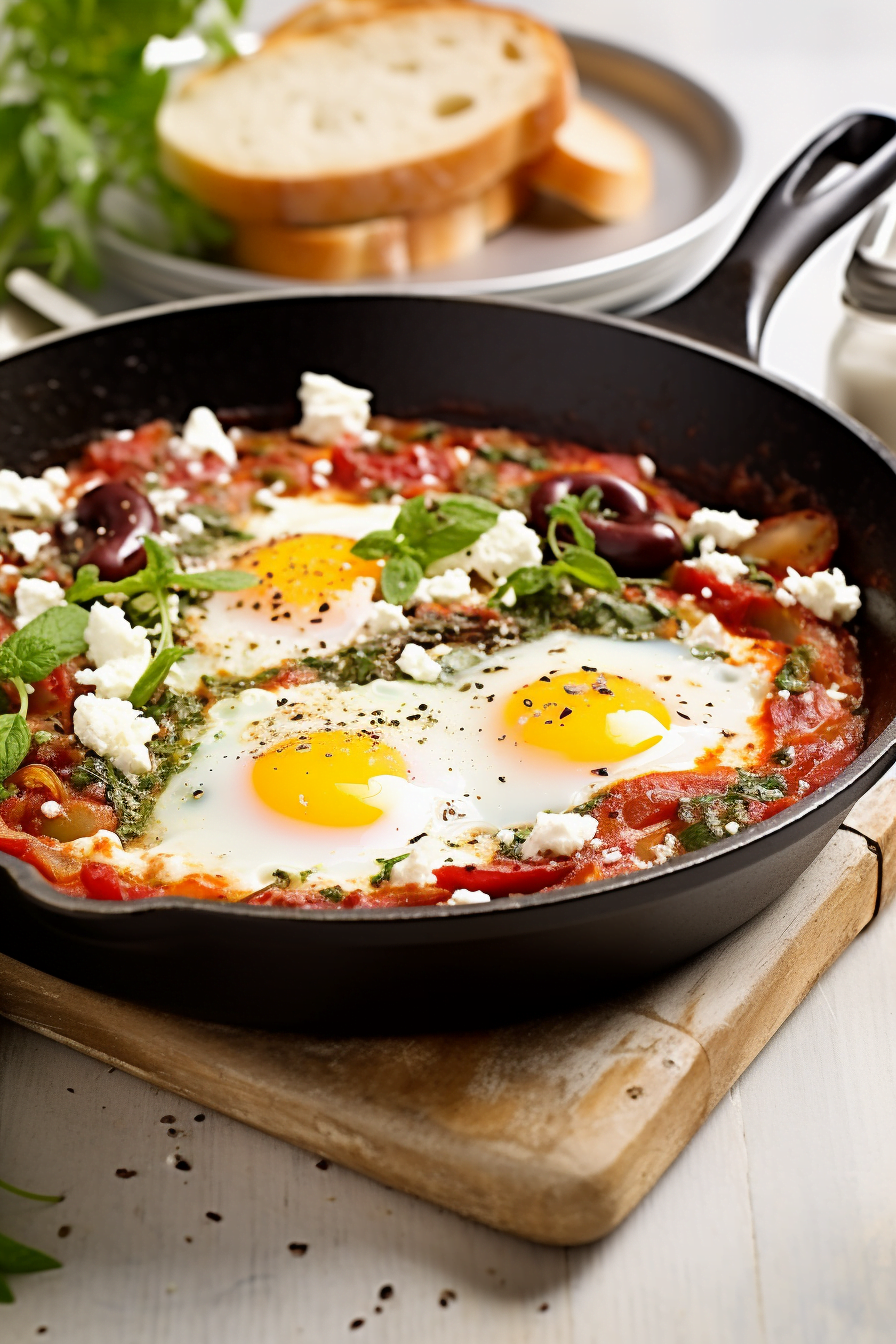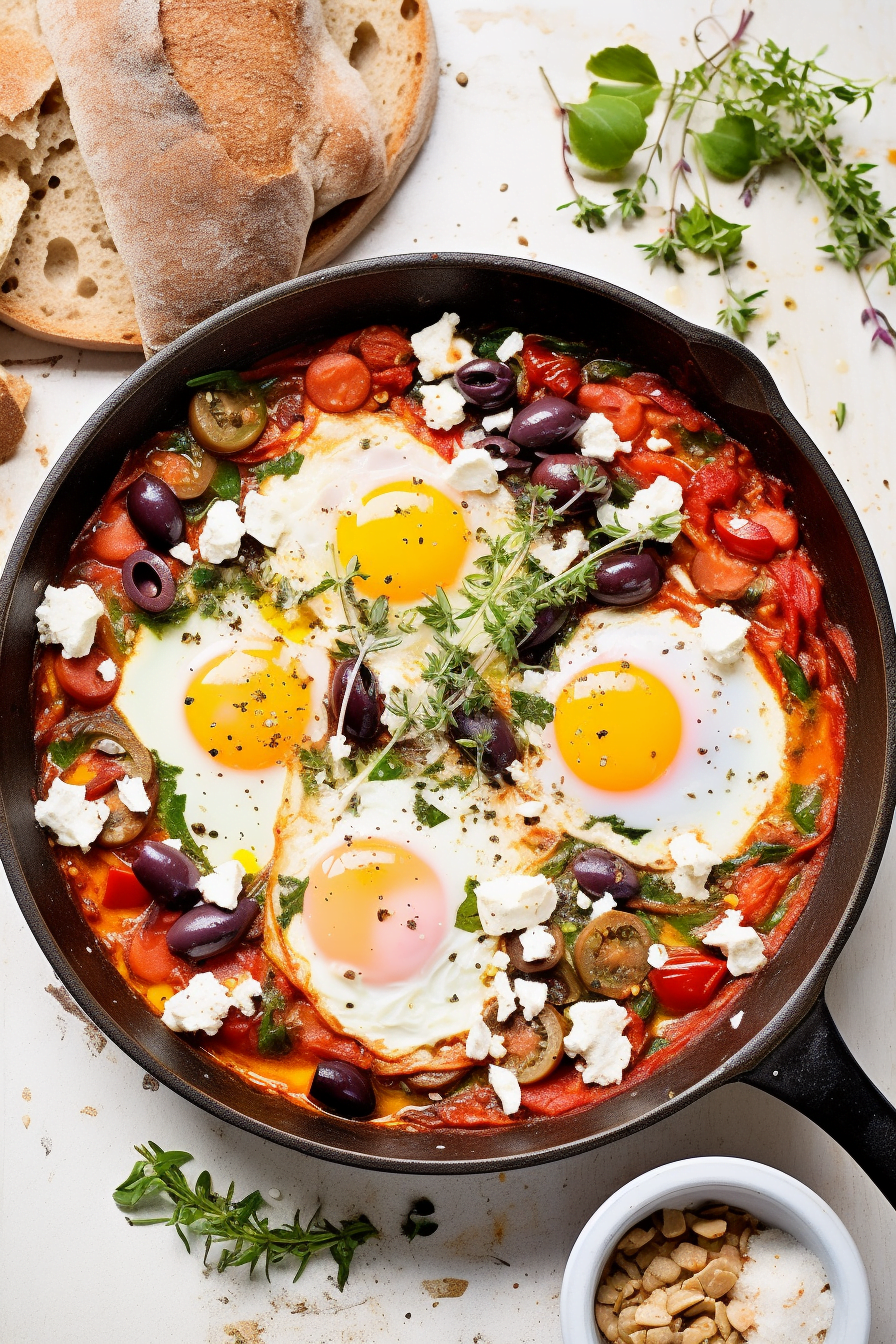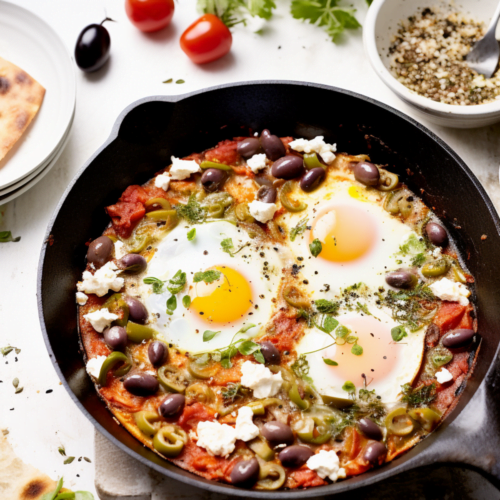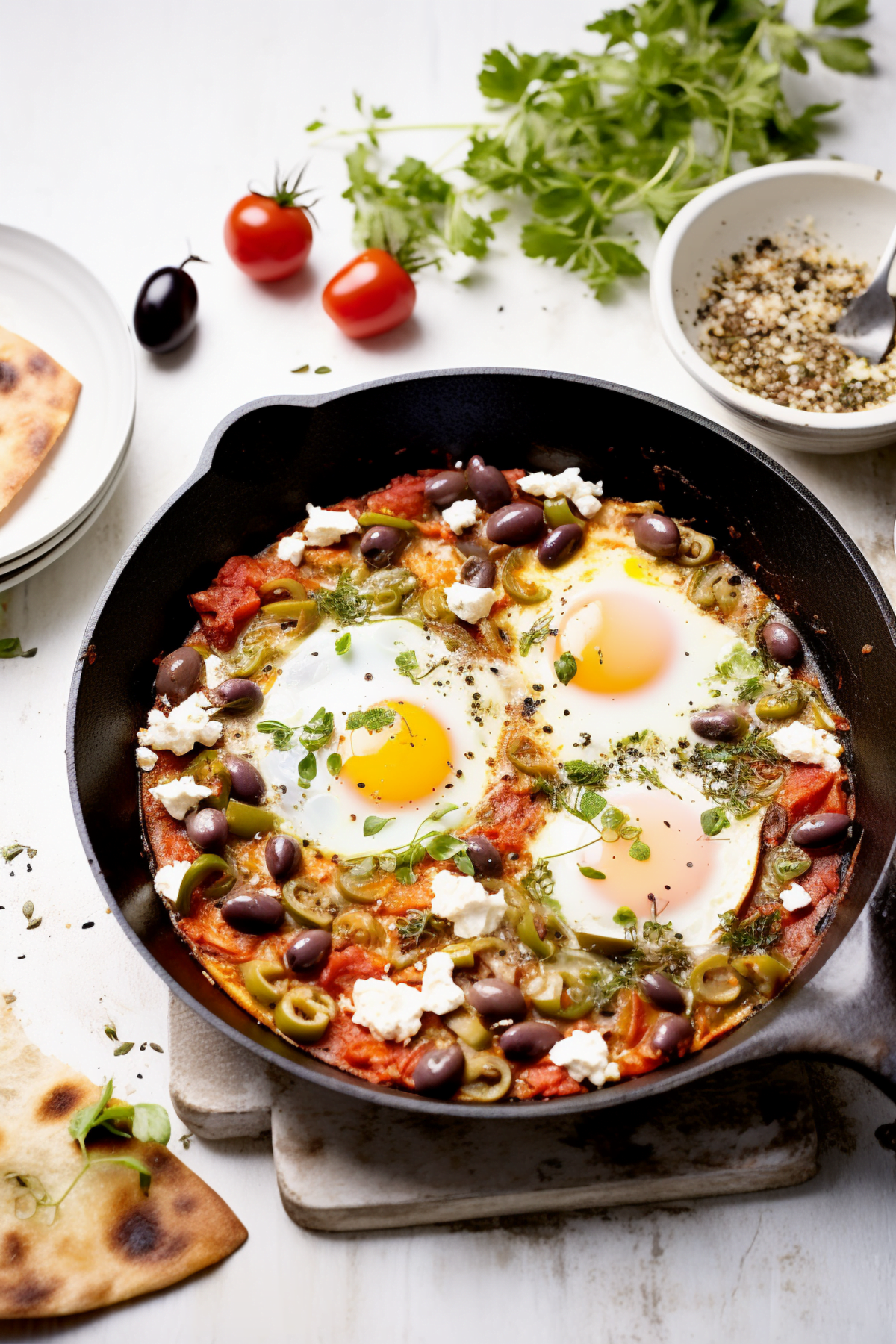Discover the Delights of Greek-Style Shakshuka with Feta and Kalamata Olives
Embark on a culinary journey to the heart of the Mediterranean with our Greek-Style Shakshuka with Feta and Kalamata Olives. This dish is a symphony of flavors, combining poached eggs in a rich tomato sauce, punctuated by the tangy taste of feta and the briny depth of Kalamata olives. Perfect for breakfast, brunch, or a light dinner, this recipe is not just a meal but an experience that will transport your senses straight to Greece.
Whether you’re a shakshuka aficionado or new to this dish, our Greek twist on the classic recipe is sure to become a staple in your kitchen. So, grab your skillet, and let’s dive into the vibrant world of Mediterranean cooking!

The Story Behind Greek-Style Shakshuka
Shakshuka may have its roots in North Africa, but it has been warmly embraced and adapted by various Mediterranean cultures, including the Greeks. The traditional shakshuka, a staple in Tunisian, Libyan, Algerian, and Moroccan cuisines, typically features a tomato and pepper sauce with eggs poached on top.
In Greece, where the diet is rich in olive oil, fresh vegetables, and dairy, the local take on shakshuka includes the addition of feta cheese and Kalamata olives, staples of Greek cuisine. This Greek-Style Shakshuka is a nod to the country’s culinary traditions, showcasing the robust flavors and simple, fresh ingredients that Greek cooking is known for.
The inspiration for this dish comes from the coastal regions of Greece, where the diet is heavily influenced by the bounty of the sea and the fertile lands. The addition of feta cheese, with its crumbly texture and salty tang, elevates the dish, while the Kalamata olives, named after the city of Kalamata in the Peloponnese region, add a touch of gourmet sophistication.
Our recipe stays true to the essence of Greek cuisine, focusing on quality ingredients and straightforward preparation. It’s a dish that tells a story of cultural exchange, local produce, and the joy of sharing a meal with loved ones.

Mastering the Method of Greek-Style Shakshuka
Creating the perfect Greek-Style Shakshuka is an art that requires a balance between simplicity and technique. Here’s how to elevate your shakshuka game with some chef’s tips:
Building the Base: Start by gently sautéing onions in extra-virgin olive oil until they are just translucent. This is the foundation of your flavor, so be patient and avoid browning them too quickly. The addition of garlic and red bell pepper should be done with care, allowing each ingredient to release its aroma without overpowering the others.
Simmering the Sauce: When adding the crushed tomatoes, ensure you’re using high-quality canned tomatoes or, if available, fresh ripe tomatoes. The spices—paprika, cumin, and optional chili flakes—should be measured with precision to achieve the perfect balance. Let the sauce simmer gently to meld the flavors together, creating a harmonious backdrop for the eggs.
Poaching the Eggs: The eggs are the stars of the show, so make sure to create distinct wells in the sauce for them to nestle into. Crack each egg carefully to keep the yolks intact. Covering the skillet is crucial for even cooking, but keep a close eye to achieve your desired doneness.
Finishing Touches: As you sprinkle the crumbled feta and Kalamata olives over the shakshuka, remember that these ingredients are not just garnishes but integral components that bring their unique textures and flavors to the dish. The final garnish of fresh parsley not only adds color but also a fresh, herby lift that cuts through the richness.
Serving the shakshuka hot from the pan allows for the communal, family-style dining that is central to Greek culture. Accompanying the dish with crusty bread is not only traditional but practical, as it sops up the delicious sauce and completes the meal.

Variations to the Greek-Style Shakshuka
Seafood Shakshuka
For a coastal twist, add shrimp or chunks of firm white fish to the tomato sauce just before you poach the eggs. The seafood will cook gently in the sauce, adding a luxurious element to the dish that’s reminiscent of the Aegean Sea’s bountiful offerings.
Vegetarian Delight
Enhance the vegetable content by incorporating spinach or Swiss chard into the sauce. This not only boosts the nutritional value but also adds beautiful color and a subtle earthy flavor that complements the tanginess of the feta and olives.
Meat Lover’s Version
Brown some ground lamb or beef with the onions at the beginning of the cooking process. The meat adds a rich depth of flavor and makes the dish even more hearty and satisfying, suitable for a main course.
Substitutions for Greek-Style Shakshuka
While our recipe is crafted to deliver an authentic taste of Greece, we understand the need for flexibility in the kitchen. Here are some substitutions to consider:
Feta Cheese Alternatives
If feta cheese is not to your liking or unavailable, try using ricotta salata or a mild goat cheese. These cheeses offer a similar crumbly texture with a less salty profile, which can be a good match for the other flavors in the dish.
Tomato Sauce Base
In the absence of crushed tomatoes, passata or even canned whole peeled tomatoes, roughly chopped, can serve as a suitable replacement. The key is to maintain the sauce’s rich tomato flavor and consistency.
Olives Varieties
If Kalamata olives are not on hand, you can substitute them with other Greek olives, such as Halkidiki or Amfissa. While the flavor profile will differ slightly, these olives still provide the characteristic Mediterranean brininess.
Frequently Asked Questions
| Question | Answer |
|---|---|
| Can I make this dish ahead of time? | Shakshuka is best served fresh, but you can prepare the tomato sauce in advance and reheat it before poaching the eggs. |
| Is this recipe gluten-free? | Yes, as long as you serve it without bread or with a gluten-free alternative, this shakshuka is gluten-free. |
| How can I store leftovers? | Leftovers can be stored in an airtight container in the refrigerator for up to two days. Reheat gently before serving. |
| Can I use dried herbs instead of fresh? | Fresh herbs are preferred for garnish, but in a pinch, dried parsley can be used. Use one-third the amount if substituting with dried. |
| What can I serve with shakshuka? | Aside from crusty bread, shakshuka pairs well with a simple green salad or roasted potatoes for a heartier meal. |

Greek-Style Shakshuka with Feta and Kalamata Olives
Equipment
- Large skillet or frying pan
- Knife and cutting board
- Measuring cups and spoons
Ingredients
- 2 tbsp extra-virgin olive oil
- 1 large onion, diced about 1 cup/150g
- 2 cloves garlic, minced
- 1 red bell pepper, seeded and diced red bell pepper about 1 cup/150g
- 2 cups crushed tomatoes
- 1 tsp paprika
- 1 tsp cumin
- 1/2 tsp chili flakes optional
- Salt and pepper, to taste
- 4 large eggs
- 1/2 cup crumbled feta cheese
- 1/4 cup pitted Kalamata olives, halved
- 2 tbsp chopped fresh parsley
- Crusty bread, for serving optional
Instructions
- Heat the olive oil in a large, deep skillet or frying pan over medium heat. Add the diced onion and sauté until translucent, about 5 minutes.
- Stir in the minced garlic and diced red bell pepper. Cook for another 5 minutes, or until the peppers are soft.
- Pour in the crushed tomatoes, and season with paprika, cumin, chili flakes (if using), salt, and pepper. Simmer the sauce for 10 minutes, allowing the flavors to meld together.
- With the back of a spoon, make four wells in the sauce. Crack an egg into each well.
- Cover the skillet with a lid and cook over low heat until the eggs are just set, about 7-10 minutes.
- Sprinkle the crumbled feta cheese and Kalamata olives over the shakshuka. Cover and cook for an additional 2-3 minutes, until the feta is slightly melted.
- Remove from heat and garnish with chopped fresh parsley.
- Serve hot directly from the pan with crusty bread if desired.
Notes

